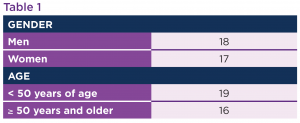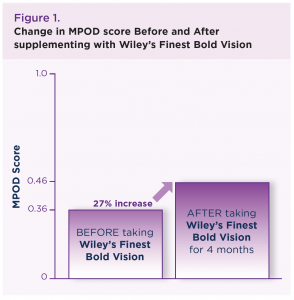Case Study:
Wiley’s Finest Bold Vision Significantly Improves Eye Health Scores
In Brief
Healthy men and women volunteered to evaluate the impact of Wiley’s Finest Bold Vision on macular (eye) health. After 4 months of supplementation, macular pigment density increased significantly — an average of 27%.
BACKGROUND
The macula is a small but crucial part of the retina in the human eye and is responsible for sharp central vision, our ability to see fine detail, and distinct color tones. The evolution in digital screen technology has advanced dramatically over the years, and many of today’s electronic devices use LED back-light technology to help enhance screen brightness and clarity. These LEDs emit strong blue light waves. Because of the wide-spread use and increasing popularity of cell phones, computers, and tablets, users are being exposed to blue light for longer periods of time. Exposure to blue light has been shown to damage the macula. If the health of the macula degenerates, central vision is lost, and only peripheral vision remains. Diet and lifestyle directly influence macular health. Lutein, zeaxanthin, bilberry, zinc, vitamin E, astaxanthin, and essential dietary fats have been shown to improve macular health.1,2,3,4,5
STUDY DESIGN
Employees and their families were recruited by email and meeting announcements. Volunteers were offered Wiley’s Finest Bold Vision capsules at no charge in exchange for free macular density testing.
Wiley’s Finest Bold Vision is a dietary supplement recommended as 2 x 550 mg capsules per day to be taken with food. One 2-capsule serving contains (i) FloraGLO® lutein (20 mg), (ii) zeaxanthin (4 mg), (iii) standardized bilberry extract (20 mg anthocyanins), (iv) zinc (11mg), (v) vitamin E (20 mg), (vi) astaxanthin (2 mg), and (vii) Omega-7 (palmitoleic acid) from concentrated fish oil (500 mg).
The MPS II by Elektron Eye Technology is a reliable, fast, scientifically validated device used by clinicians to measure macular density, formally called Macular Pigment Optical Density (MPOD). Low MPOD scores are associated with higher risk of macular decline and compromised vision, especially in advanced age. Higher MPOD scores are associated with better visual performance, such as less glare, eye strain, better night driving vision, and greater protection from blue light damage.6,7,8,9
Specifically, volunteers completed MPOD testing and were given two bottles of Bold Vision on the same day. At the 2-month mid-way point, volunteers completed a one-page questionnaire and collected 2 more bottles of Bold Vision. At the end of four months, volunteers completed a two-page questionnaire and MPOD testing. A four-month interval between testing was chosen because it takes at least 3 months for tissue (eye) concentrations of fat-based nutrients, as found in Bold Vision, to measurably change. The questionnaires were anonymous, and the test scores were kept confidential. Only the Tester and Project Manager had access to the test scores held on a private database.
RESULTS
35 men and women completed testing. See Table 1.

Two volunteers reported a known family history of macular decline. About 2/3 of the volunteers reported taking a multiple vitamin/mineral and fish oil supplements. More than 50% reported supplementing in the morning and/or with a meal; no stomach upset was reported. The average MPOD score at baseline was 0.36 and after 4 months of supplementation, the average MPOD score was 0.46. Statistical T-tests of within-subject changes to MPOD scores after 4 months were performed.
See Table 2.

The T-tests results showed a statistically significant 27% increase in MPOD score (P<0.00001) after 4 months of supplementing with Wiley’s Finest Bold Vision.
See Figure 1.
DISCUSSION
This case study is the first to evaluate Wiley’s Finest Bold Vision in generally healthy adults using a clinically validated method. The average baseline score of volunteers was 0.36 which is consistent with the average reported for the general USA population. The 27% increase in MPOD score over four months is a substantial increase in macular density. Volunteers can also expect improvements in visual performance, including less glare, less eye strain, better night driving vision, and greater protection from blue light damage. Perhaps most importantly, improving the density of the macula will support better and longer macular health and clear vision as we age.
References:
1 Johnson EJ. Nutrition Reviews 2014:72:605-612.
2 Kawabata F, Tsuji T. Biomed Res 2011;32:387-393.
3 Grahn BH, Paterson PG, et al. J Am Coll Nutr 2001;20:106-118.
4 Rasmussen HM, Johnson EF. Clin Interv Aging 2013;8:741-748.
5 Miljanovic B, Trivedi KA, et al. Am J Clin Nutr 2005;82:887-893.
6 Stringham JM, Stringham NT, O’Brien KJ. Foods 2017;6:doi:10.3390
7 Loskutova E, Nolan J, et al. Nutrients 2013;5:1962-1969.
8 Hammond BR, Fletcher LM, et al. Invest Ophthalmol Vis Sci 2014;55:8583-8589.
9 Stringham JM, Hammond BR. Optometry & Vis Sci 2008;85:82-88.
Disclaimer: This case study is provided for educational purposes only. It is not intended as medical advice. Always consult your healthcare provider for medical advice.
These statements have not been evaluated by the Food and Drug Administration. This product is not intended to diagnose, treat, cure, or prevent any disease.
Find out more about Bold Vision: Proactive.




